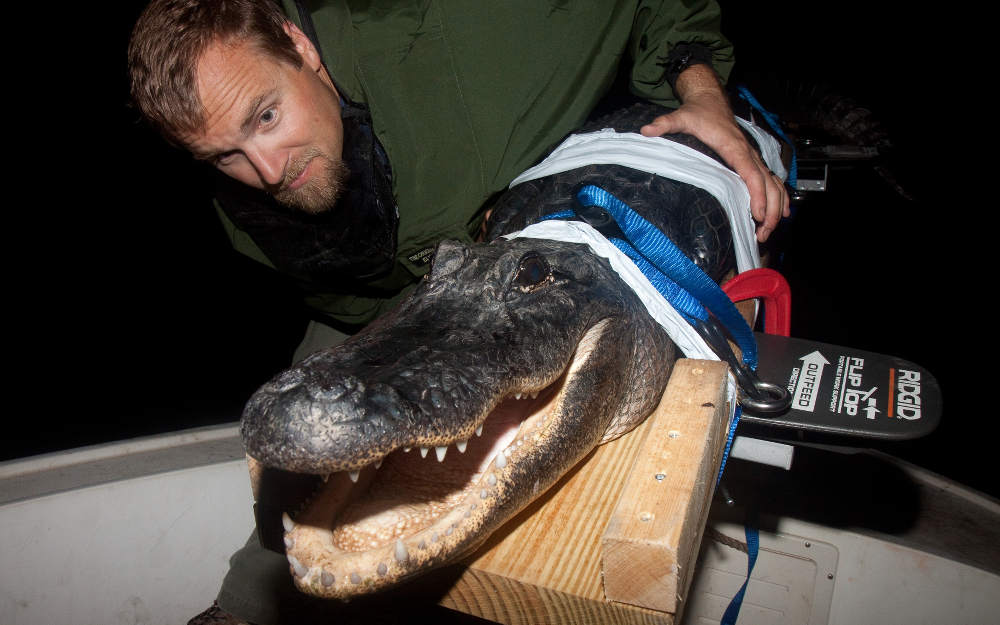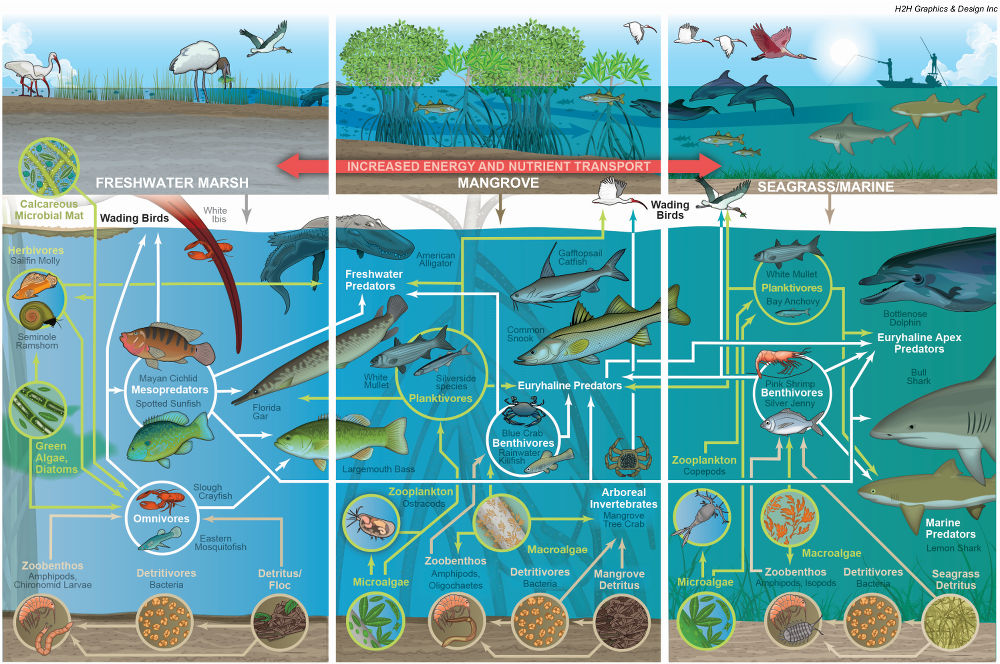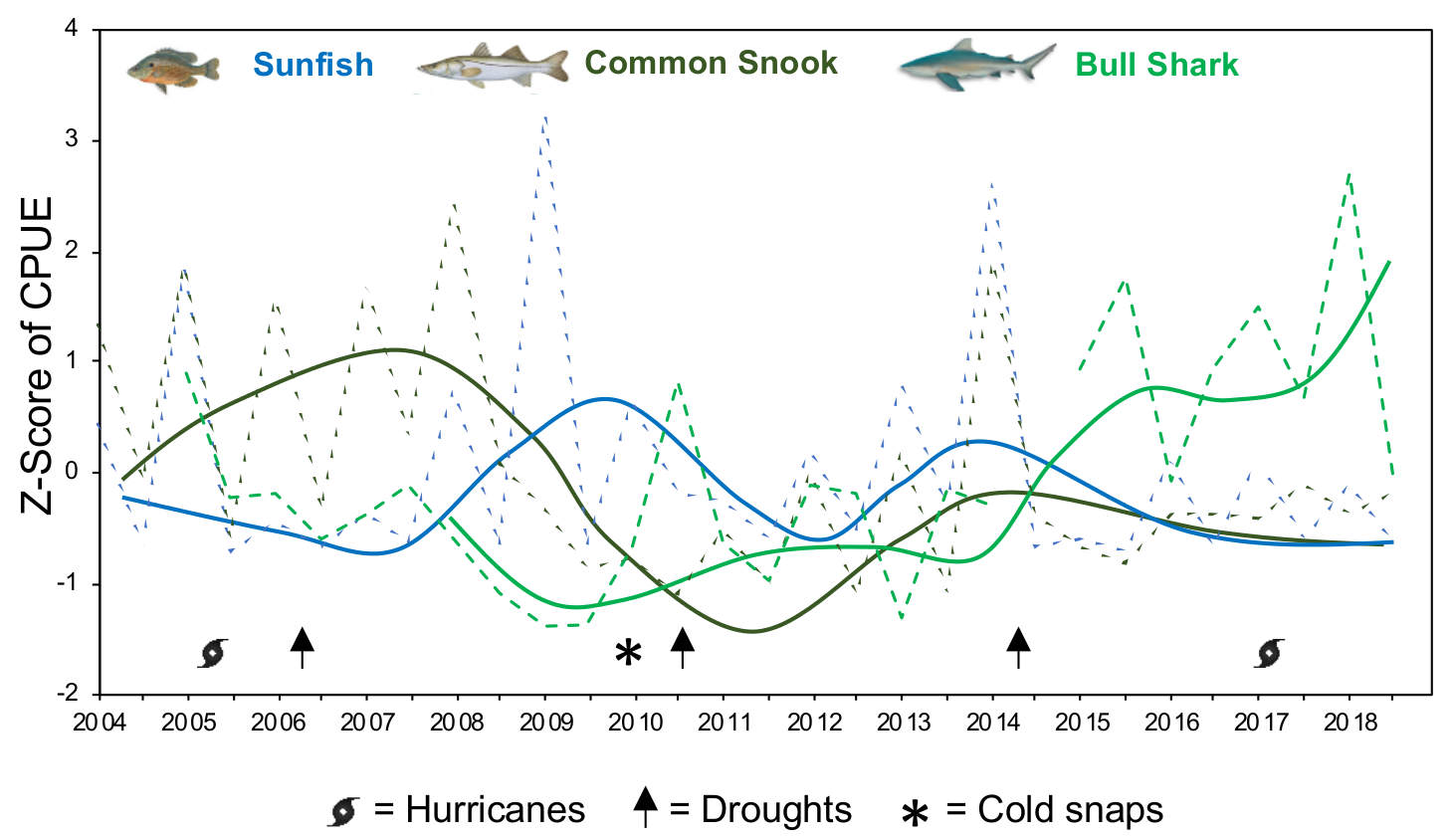FCE scientists discovered that decomposing plant material, rather than the plants themselves, supports the freshwater food web. When exported to coastal waters, this material also supports substantial marine plant and animal life.
- Key Findings
Determining the sources, fate, and transport of dead organic matter is an important aspect of understanding the linkages between freshwater and marine environments in estuaries such as the Everglades. Comparative work among aquatic sites in the LTER network has shown that the dissolved form of organic matter is abundant in the Everglades but less biologically available compared to other estuaries. However, particulate organic matter, found as a detrital layer above the soil surface, is formed in unusual quantities in the freshwater Everglades and moves slowly as bedload into estuaries. FCE researchers have shown that this material, rather than the living or dissolved form, forms the base of the Everglades food web.

Michael Heithaus prepares to place a GPS tag on an alligator. Using these, and much smaller acoustic transmitters, FCE researchers have been able to show that some alligators commute from marine waters where they feed to the ecotone, possibly moving important nutrients upstream. Large mobile consumers, such as bull sharks and alligators, may play a role in transporting nutrients upstream from the Gulf of Mexico. Although they reside primarily in low-salinity areas particular individual alligators and bull sharks will commute to the coastal oceans to feed before returning back upstream. Alligators in particular may link the marshes, estuaries, and coastal ecosystems through their movements and feeding patterns.
In addition, when detrital material meets the estuary, metabolic rates are high, suggesting its importance to nutrient regeneration and biogeochemical cycling. The particulate matter was found to be highly reactive upon exposure to sunlight, resulting in the release not only of high levels of dissolved carbon, but also nutrients. These processes have implications for Everglades' restoration, as expected increases in freshwater inflows should increase detrital transport to estuaries, increasing nutrient availability via diverse re-mineralization processes.
- Results

Diagram of the Florida Coastal Everglades food web illustrating numerically dominant species in the major functional groups and the key basal resources across freshwater marsh, mangrove and seagrass/marine food webs. The influence of increased freshwater and marine pulses are expected to alleviate phosphorus limitation and increase production and energy flux through higher quality algal-based trophic pathways (green arrows) relative to lower-quality detrital pathways (brown arrows - consumers that rely on both pathways are shown with white arrows); increasing trophic efficiency, secondary production, and trophic coupling across habitats via increased movement of mobile consumers.

Seasonal catch per unit effort (CPUE) of dominant large estuarine consumers (Common Snook and Bull Sharks) and their freshwater prey (Lepomis sunfishes) which pulse into SRS, with LOESS curves (a locally estimated regression approach) overlaid to illustrate long-term trends. Values are averaged across wet (Jun-Dec) and dry (Jan-May) seasons. Hurricanes, droughts, and cold snaps are determinants of both prey and consumer abundance.

Small-bodied consumers track organic matter sources. A wide separation in δ34S values can be used to distinguish freshwater-derived organic matter from seagrass and mangrove habitats while δ13C values can distinguish between seagrass- and mangrove-derived organic matter.
- Related Publications
Boucek, R. and J.S. Rehage. 2014. Climate extremes drive changes in functional community structure. Global Change Biology 20: 1821-1831. DOI: 10.1111/gcb.12574
Boyer J.N., S.K. Dailey, P.J. Gibson, M.T. Rogers, D. Mir-Gonzalez. 2006. The role of dissolved organic matter bioavailability in promoting phytoplankton blooms in Florida Bay. Hydrobiologia 569:71-85.
Jaffe, R., D. McKnight, N. Maie, R. Cory, W.H. McDowell, J.L. Campbell. 2008. Spatial and temporal variations in DOM composition in ecosystems: The importance of long-term monitoring of optical properties. Journal of Geophysical Research - Biogeosciences 113: G04032.
Maie, N., J.N. Boyer, C. Yang, R. Jaffe. 2006. Spatial, geomorphological, and seasonal variability of CDOM in estuaries of the Florida Coastal Everglades. Hydrobiologia 569: 135-150.
Matich, P., J.S. Ault, R. Boucek, D.E. Bryan, K.R. Gastrich, C.L. Harvey, M.R. Heithaus, J.J. Kiszka, V.A. Paz, J.S. Rehage, and A.E. Rosenblatt. 2017. Ecological niche partitioning within a large predator guild in a nutrient-limited estuary. Limnology and Oceanography 62: 934-953. DOI: 10.1002/lno.10477
For more information, contact Jennifer Rehage.